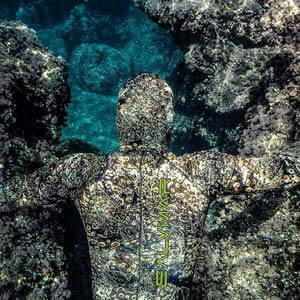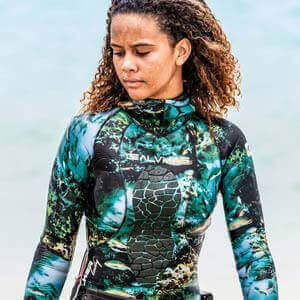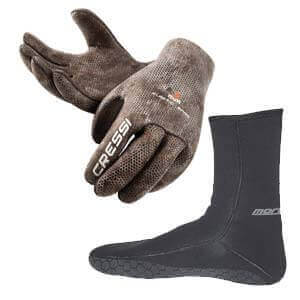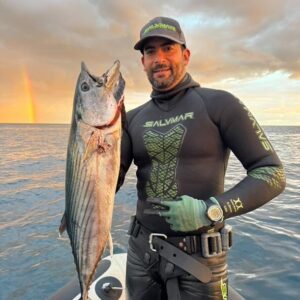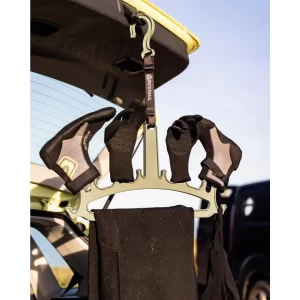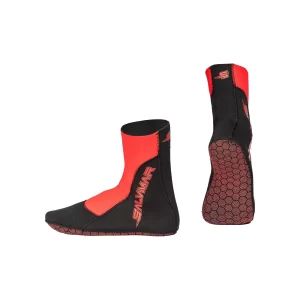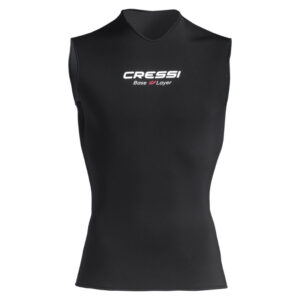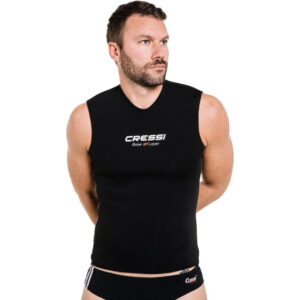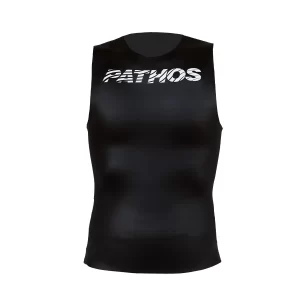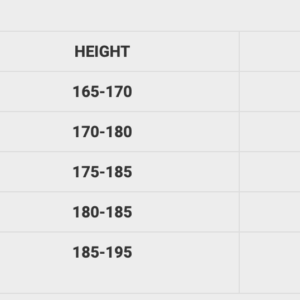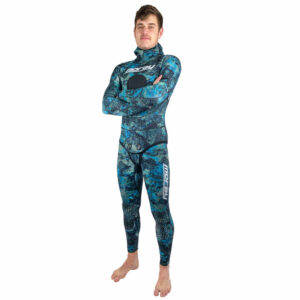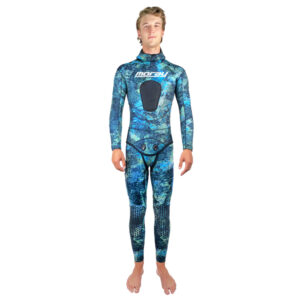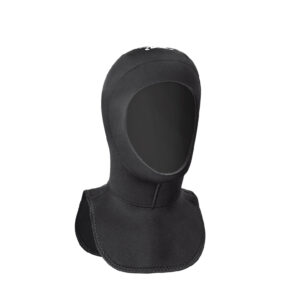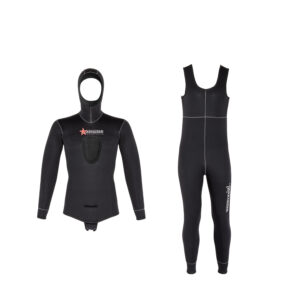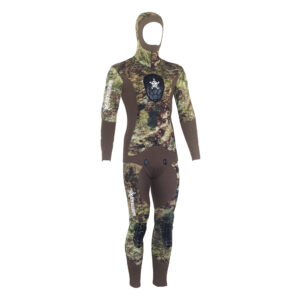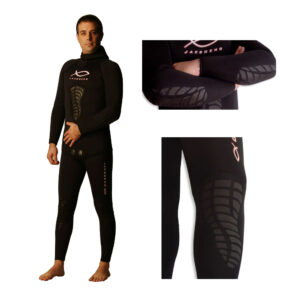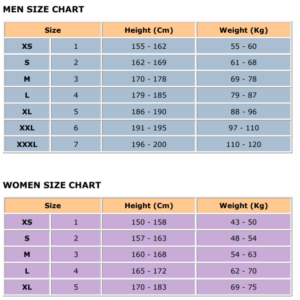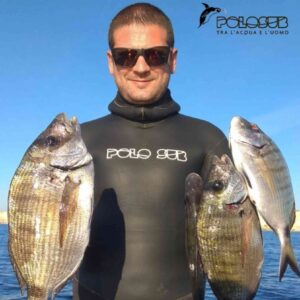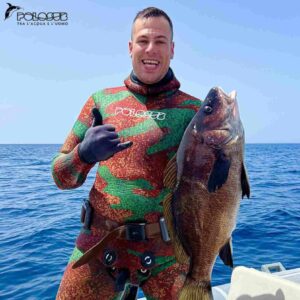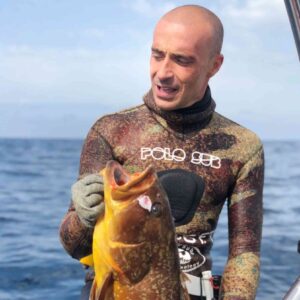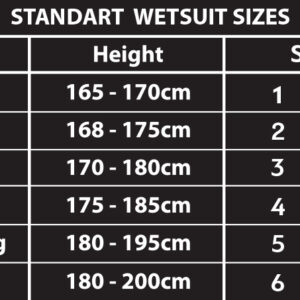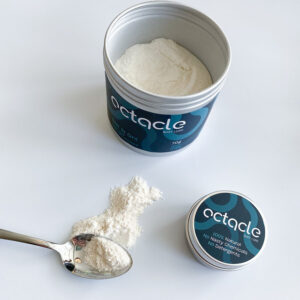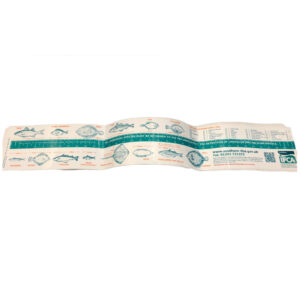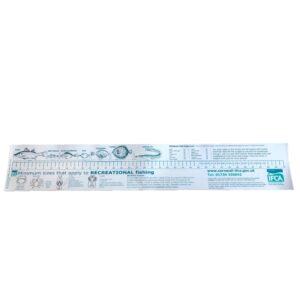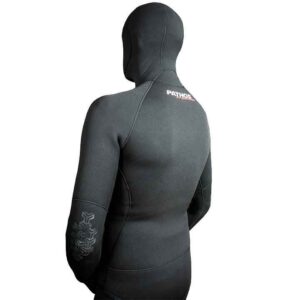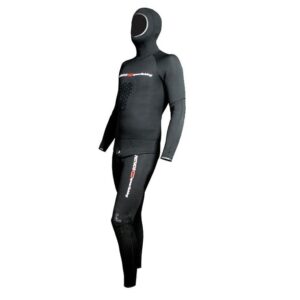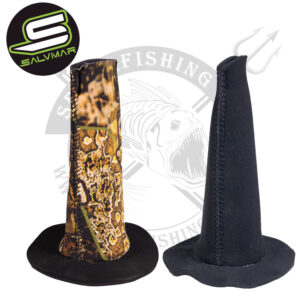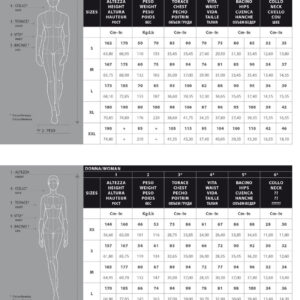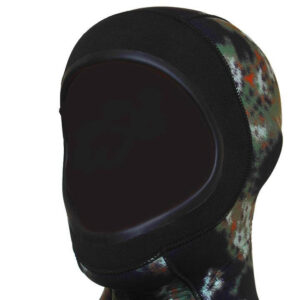Spearfishing Wetsuits
Spearfishing wetsuits make a phenomenal difference when you first switch to them.
Spearfishing wetsuits are made up of two parts, commonly Farmer John style trousers that continue up over the torso and are held up with shoulder straps like thick dungarees. Over that you will also have a hooded wetsuit top, so 10mm over your core.
They use a very different type of neoprene to watersports wetsuits – it’s much more resilient to compression, which is critical for retaining heat when submerged. Water sport wetsuits like surf suits are designed to be used on the surface of the ocean, not below it – so compression resistance isn’t a concern when the brands are choosing the type of neoprene they want to use. As spearos spend most of their time fully submerged in the ocean, this extracts heat from the body far quicker. At 10m under the water, a surf suit will be nearly paper thin and offer little protection from the cold, as well as being prone to damage. A good spearo suit will retain its thickness and thus warmth at these depths and well beyond.
Why you should never use detergent to get into your wetsuit (octacle.co.nz)
Spearfishing wetsuits often feature loading pads to stop those bruises when loading your gun, and padded knees and elbows to deal with the terrain commonly encountered.
In the UK the majority of spearos will wear a 5mm wetsuit all year round. A few that feel the cold may opt for a 5/7mm split – this is 5mm wetsuit pants with a 7mm wetsuit top. Or, if you live in the north, such as Scotland where the water temperature remains cold even in the summer, you’re going to want to look at full 7mm wetsuits. A lot of the hardcore winter divers will probably switch to a 5/7mm split or a full 7mm suit as the temp drops.
Quick links:
- Download our free Spearfishing Wetsuits guide (PDF).
- Wetsuits and accessories clearance items
- Wetsuit FAQs
Need help? Call us on 01726 213290 or email: enquiries@spearfishing.co.uk
Showing 1–48 of 137 resultsSorted by latest
Spearfishing Wetsuits Buyer’s Guide
Need help? Call us on 01726 213290 or email: enquiries@spearfishing.co.uk
Spearfishing wet suits make a phenomenal difference when you first switch to them.
A lot of people come to spearfishing from other walks of life like surfing etc. As such, they naturally use what they have handy to get started while they test the waters and see if it’s right for them.
Most people will start using an old surf wetsuit – a 5mm / 3mm suit is very common. If you are one of those people and you are wondering if buying a spearfishing specific wetsuit is really worth the money, then this is what you can expect.
In the UK the majority of spearos will wear a 5mm spearfishing wet suit all year round. A few that feel the cold may opt for a 5/7mm split – this is 5mm pants with a 7mm wetsuit top. Or, if you live in the north, such as Scotland where the water temperature remains cold even in the summer, you’re going to want to look at full 7mm suits. A lot of the hardcore winter divers will probably switch to a 5/7mm split or a full 7mm wetsuit as the temp drops.
Right now you are probably thinking that your surf suit is 5mm so there won’t be much difference – very wrong.
The main difference is that spearfishing wet suits use a very different type of neoprene – it’s much more resilient to compression, which is critical for retaining heat when submerged.
Water sport wetsuits like surf suits are designed to be used on the surface of the ocean, not below it – so compression resistance isn’t a concern when the brands are choosing the type of neoprene they want to use.
As spearos spend most of their time fully submerged in the ocean, this extracts heat from the body far quicker. At 10m under the water, a surf suit will be nearly paper thin and offer little protection from the cold, as well as being prone to damage. A good spearo suit will retain its thickness and thus warmth at these depths and well beyond.
When choosing neoprene for a particular purpose, manufacturers have to largely choose between compression resistance and stretch factor (i.e. comfort). The more resistant to compression a neoprene is, the less stretchy it can be. So they look to choose the optimal balance for their sport.
It’s worth mentioning that not all spearfishing wet suits are designed the same. Some are aimed at people who prominently dive deeper than 15m. The neoprenes are slightly less comfortable but will keep you warmer at those depths.
As most UK spearfishing is done well above 15m – mostly between 2 – 10m – it’s not overly important to factor this in to your decision making, unless you have other plans as well.
Japan is the largest export of high-quality neoprene with two main factories producing it. While every brand out there has a different opinion on what formula makes the perfect spearfishing suit, their origins can normally be traced back to Japan. Yamamoto is currently the most popular and comes in 3 different compression resistant variations. This is followed by Heiwa AWS, a very compression resistant material aimed at people who spend a lot of time below 15m.
One piece or two?
The second major difference you’ve probably already noticed is spearo suits are made up of two parts: a hooded jacket with trousers, rather than a single unit. The trousers will be either high-waisted or farmer-john style (with shoulder straps like dungarees). Both of these variations continue up over the torso, meaning that over your core you actually have two layers of 5mm wetsuit material giving you 10mm thickness. This keeps you very warm.
The hood on the jacket also obviously helps keeps the heat in – we all know the head loses a great deal of body heat.
As an example, during summer in the south, water temp generally ranges between 16 and 18 degrees Celsius. You can probably last 60 – 90 mins submerged in a surf suit before the shakes kick in and you need to get out, no matter how resilient you are to the cold. In a two-piece spearfishing wetsuit, that will increase to six – eight hours before the cold forces you out – a pretty big difference! So to answer the question of whether this upgrade is right for you, it simply comes down to how long you want to spearfish for.
Are all wetsuits for spearfishing the same?
Most people don’t know that the majority of high-quality wetsuits are made in the same set of factories, or if they are not put together there then you can trace the manufacturing of the neoprene back to those same factories. This isn’t a bad thing, but many brands will go to great lengths to convince you their suits are better/warmer than the others when in reality, many are pretty similar with a different cut and slightly different features. We try to stay away from that game and as with everything we stock, we only focus on the real performers that we feel represent the pinnacle options in relation to quality and performance. They may not be the cheapest options out there, but we are happy with that and wouldn’t compromise for anything.
Warmth is the major consideration – however, there are other factors to bear in mind:
Loading pads – spearo wetsuits have a padded chest area to stop those bruises when loading your gun.
Padded knees and elbows – we tend to find ourselves crawling up all manner of rocks and nasty terrain when trying to get out for a rest. These pad are designed to improve the longevity under challenging conditions.
Camouflage – looking for that extra edge? We’re not sure if fish really care, but as long as you don’t look like a predatory seal it can’t harm.
Open cell verses closed cell (nylon lined) neoprene. Closed cell suits are what you will almost always see in surf suits. They have a lining on the inside of the suit and this makes it exceptionally easy to get into the suit. However, the downside is that this nylon lining holds water, I’ll go into more detail about this in a moment.
Open cell neoprene does not have this lining on the inside – it is pure rubber. This makes it impossible to get on, unless you use lubricant. Most people will use a little bit of hair conditioner – however we would recommend using Slippy as it is 100% natural and doesn’t harm the water or your skin. With the use of lubricant, you’ll slide right into an open cell wetsuit. Being pure neoprene, it clings to your skin to a greater extent than a lined suit. This is ideal as it reduces the chance of water flushing into your suit, sweeping all that warmth you’ve put into there out. Pure neoprene also has the benefit of wicking water away quickly – going back to the lining reference above. The lining will absorb water by introducing more water into the suit than open cell (by contrast) would allow. Having more water in contact with your body removes your body heat at a much faster rate.
Long john or high waist pants?
There’s quite a big difference between these two styles. High waist pants are the most popular as spearfishing is a huge sport across the warmer regions of the planet where they don’t need the added neoprene to keep warmer.
High waist pants are also popular for those who would like to go for a mid-session toilet break. With the farmer-johns you will need to take your jacket off so you can pop down the pants. With the high waist pants you can simply undo the buttons on your jacket and then ‘take care of business’. While we would say most divers just pee straight into their suit, don’t underestimate how much colder this makes you – it’s a huge factor. The extra liquid trapped in your suit rapidly drops in temperature and starts extracting your body heat.
With the invention of the mighty Pissette, this is less of a consideration (for the dudes at least!) Even with high waist pants, pulling your high waist pants down in 15C water isn’t a nice prospect, so a pissette is highly advantageous. While the thought of cutting a hole in your lovely new wetsuit may seem terrifying, the whole process is much easier than it looks. There are plenty of great videos out there to take you through the process step by step.
You can add pissettes to Farmer johns too. These are a pinnacle of cold water spearfishing because they cover your most important organs such as your heart and lungs and double up the neoprene. If you’re wearing a 5mm suit with Farmer Johns, your heart and lungs will be protected by 10mm of neoprene and not 5mm that the high waist would offer you. Farmer johns make a huge difference for warmth! But, there is one additional downside with this style. With added neoprene comes added lead. You may need an extra 1-2kg of lead to be neutrally buoyant at the same depth as high waists would provide.
Wetsuit thicknesses
As we mentioned above, the most common all year-round thickness is 5mm but some people opt for a 5mm pants with a 7mm top, or just a full 7mm suit. While the thought of the extra warmth is appealing, there are some serious considerations to be made here. Namely, the extra neoprene in the thicker suits will need extra lead weights on your dive belt for you to be able to spearfish properly. Neoprene is incredibly buoyant, so all divers need weights to help them dive to the bottom and stay there without floating back up. You will need more weight to become negatively buoyant with a thicker suit.
Extra weight just makes everything that little more awkward: from walking to your dive spot, to cruising the ocean floor during a dive. Also, overheating during the summer months will end your dive session just as quickly (if not quicker) as becoming too cold in the height of winter.
What thickness wetsuit socks and gloves do I need?
In summer we like 3mm socks and gloves – that’s what the vast majority of spearos will use. If you are susceptible to the cold then you can go up to 5mm no problem – but the only downside to that is that, particularly with the gloves, you can lose some dexterity because the thicker neoprene just makes it harder to move your fingers. It’s harder to feel things like mask toggles and zips, and to clip and unclip things. The thicker the gloves, the more awkward it is.
If you become a winter diver, then a lot of winter spearos will switch out the 3mm for 5mm and that makes a lot of difference.
Remember if you’re switching 3mm socks to 5mm socks then there’s a chance your fins are going to feel too tight because you’ve bought them to be matched up with 3mm socks.
So if you’re buying fins and you think you’re going to dive in winter as well as summer, then it might be worth considering just making sure there’s a bit of extra room to accommodate the thicker socks. If you choose fins with a bit of room, you can use some fin savers in the summer and then of course, you won’t have to use them in winter.
One thing’s for sure though: if your feet are tight in your foot pocket, it will lead to cramp at some point in the not-too-distant future. Foot cramp will ruin your dive session and for that reason, if I’m between sizes, I’ll always go for the size up and opt for a fin saver.
For traditional UK diving which is predominately within 12 meters, if you have a slightly loose fin pocket, you’re not going to notice much difference. If you’re a very deep diver, pushing serious depths, then you’ll always want a really snug fit – not tight but just the perfect fit – because that’ll allow you to get the maximum amount of energy return from your blade. If you’re just hitting 12 to 15 metres, you’re really not going to notice any difference if you have the slightly looser fins, but you will have the benefit of being able to use a 5mm foot pocket during the colder times of the year.
On a side note, wetsuit socks are just something you’re going to eat through – you’ll go through endless amounts of these during your spearfishing career. The only sock that I know that will last significantly longer than others is the commercial grade Ruku sock which has a Kevlar patch over the sole. These are a lot more resilient to holes or scuffs.
You’ll find most people wear something like crocs to walk to the beach and back. If you’re walking in just your neoprene socks from the car park to your dive spot, you’ll go through a couple of sets in a season if you’re a regular diver. Get crocs or something similar – you can wear those to walk to your dive spot, clip them to your float and your socks will suffer less wear.
Do I need a camouflage spearfishing wetsuit?
It is completely down to you whether you buy a camouflage spearfishing wetsuit or not. Camouflage doesn’t help in the traditional sense that you would think camo would help you with – but what it does do is stop you looking like a predatory seal. Imagine yourself wearing a black or dark single-colour wetsuit and you dive down and you’re hiding amongst the kelp – if you’re in a black wetsuit you’re going to look like a large black predatory animal so it’s certainly not going to do you any favours.
A camo wetsuit is going to at least break up your outline and make you look like less of a threat, but you’re never going to hide from the fish – they’ll always know you’re there. In fact, generally speaking, fish are very inquisitive, and you want them to know you’re there, so quite often we’ll dive down to a reef and make a little bit of noise, like we’ll twang the bands on a speargun or make a grunting noise with our throat. It’ll just announce your presence and any fish in the area will come and check you out, and hopefully give you the opportunity to take a shot.
There has also been a large surge in red camouflage spearfishing apparel recently. The theory behind the bright red wetsuit is that you’re highly visible on the surface of the ocean for other ocean users, boat users and in an emergency situation when you need to get rescued. However, as soon as you drop below 5 feet, that red turns to brown which matches the UK kelp pretty well. So you get the best of both worlds: you get a nice appropriately coloured camouflage when you’re actually diving and you get some nice high vis on the surface which is what you want to stay safe.
How much of a difference does it make overall though? Most experienced spearos will say very little or next to none, so go for what you like and feel comfortable in, and don’t worry too much about this aspect 🙂
What is a smoothskin wetsuit and do i need it?
When neoprene is made, they pour enough solution to fill large rectangular moulds a few meters squared. After it sets, they slice it into layers at whatever thickness then need to create their suits, e.g. 5mm, 7mm and so on. The top and bottom layer from each mould has an ultra-smooth, shiny finish to it. The sheets from the top and bottom are the smooth skin neoprene.
Neoprene as a raw sheet is fragile – it’s easy to tear or put your finger through it. Most neoprene has layer of nylon or spandex attached on top of it to stop it stretching too far and tearing. This is what most wetsuits are made from. They are durable and stand up the rigours of the job.
The downside to this nylon outer covering is that it holds water and slows down the drying process. This evaporative cooling process can really drain your body temperature when you get out of the water in the same way you get super cold when you get out of the swimming pool and speed walk to your locker.
So while the smooth skin suit may be much more delicate, it doesn’t retain that warmth-extracting layer of cold water on the outside. This is particularly noticeable when boat diving and when you’re speeding off to hit different spots. It’s also worth noting that boat diving puts less stress on the wetsuit as you are not climbing over jagged rocks all day. So all-in-all, it lends itself well to that boat environment.
It also needs to be said that neoprene with no nylon layer is extremely stretchy. While this stretchiness makes it fragile, it also makes it incredibly comfortable and hugs your body immensely well, further adding to its warmth.
Something relatively new on the emerging market is a type of sandwich neoprene. This has a layer of normal neoprene, then a layer of nylon followed lastly by a layer of smooth skin. The result is that you get all the warm benefits of smoothskin with the durability of the nylon layer.
While smooth skin is expensive enough, the sandwich version is even heavier on the wallet.
As a general recommendation we’d say that unless you comfortable with the price and potential hazards, you really don’t need smoothskin for traditional shore diving. However, if you’re planning to spend a lot of time on the boat, then definitely put this on your radar.
The most important part: the fit!
100% the most important aspect to getting the best wetsuit for you is the fit. It doesn’t matter how expensive a wetsuit is, what it’s made out of and what features it has. If it isn’t a snug fit then it will not keep you warm.
Any part of the suit that doesn’t hug your skin will fill up with seawater – all gaps will be filled. That sea water will extract your body heat as fast as it is able. This is why some people only use custom made wetsuits, to get that perfect fitting, snug wetsuit to extend their ocean time as long as possible.
Every manufacturer has their own tailored suits. Some are aimed at the Italian beanpoles – others more at the dad bods! When speaking with your dive shop, this should be the very first question you ask – “What suits have you got that will fit my body shape?” The more suits they stock, the more reliable their recommendations will be. Don’t underestimate how important this factor is – it really is the number one question you should be asking.

